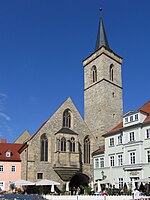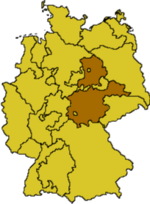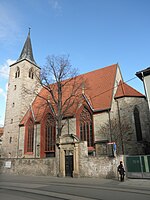Krämerbrücke
Bridges with buildingsBuildings and structures in ErfurtDeck arch bridgesHeritage sites in ThuringiaMedieval German architecture ... and 7 more
Medieval architecturePedestrian bridges in GermanyRoads in ThuringiaStone bridges in GermanyTimber framed buildings in GermanyTourist attractions in ThuringiaUse British English from August 2021

The Krämerbrücke (pronounced [ˈkʁɛːmɐˌbʁʏkə]; Merchants' bridge) is a medieval arch bridge in the city of Erfurt, in Thuringia, central Germany, which is lined with half-timbered shops and houses on both sides of a cobblestone street. It is one of the few remaining bridges in the world that have inhabited buildings. It has been continuously inhabited for over 500 years, longer than any other bridge in Europe. The stone, pedestrian bridge, which dates from 1325, is one of the oldest secular structures in Erfurt. It spans the Breitstrom, a branch of Gera River, and connects two town squares – Benediktsplatz and Wenigemarkt.
Excerpt from the Wikipedia article Krämerbrücke (License: CC BY-SA 3.0, Authors, Images).Krämerbrücke
Krämerbrücke, Erfurt Altstadt
Geographical coordinates (GPS) Address External links Nearby Places Show on map
Geographical coordinates (GPS)
| Latitude | Longitude |
|---|---|
| N 50.978611111111 ° | E 11.030833333333 ° |
Address
Krämerbrücke
Krämerbrücke
99084 Erfurt, Altstadt
Thuringia, Germany
Open on Google Maps











